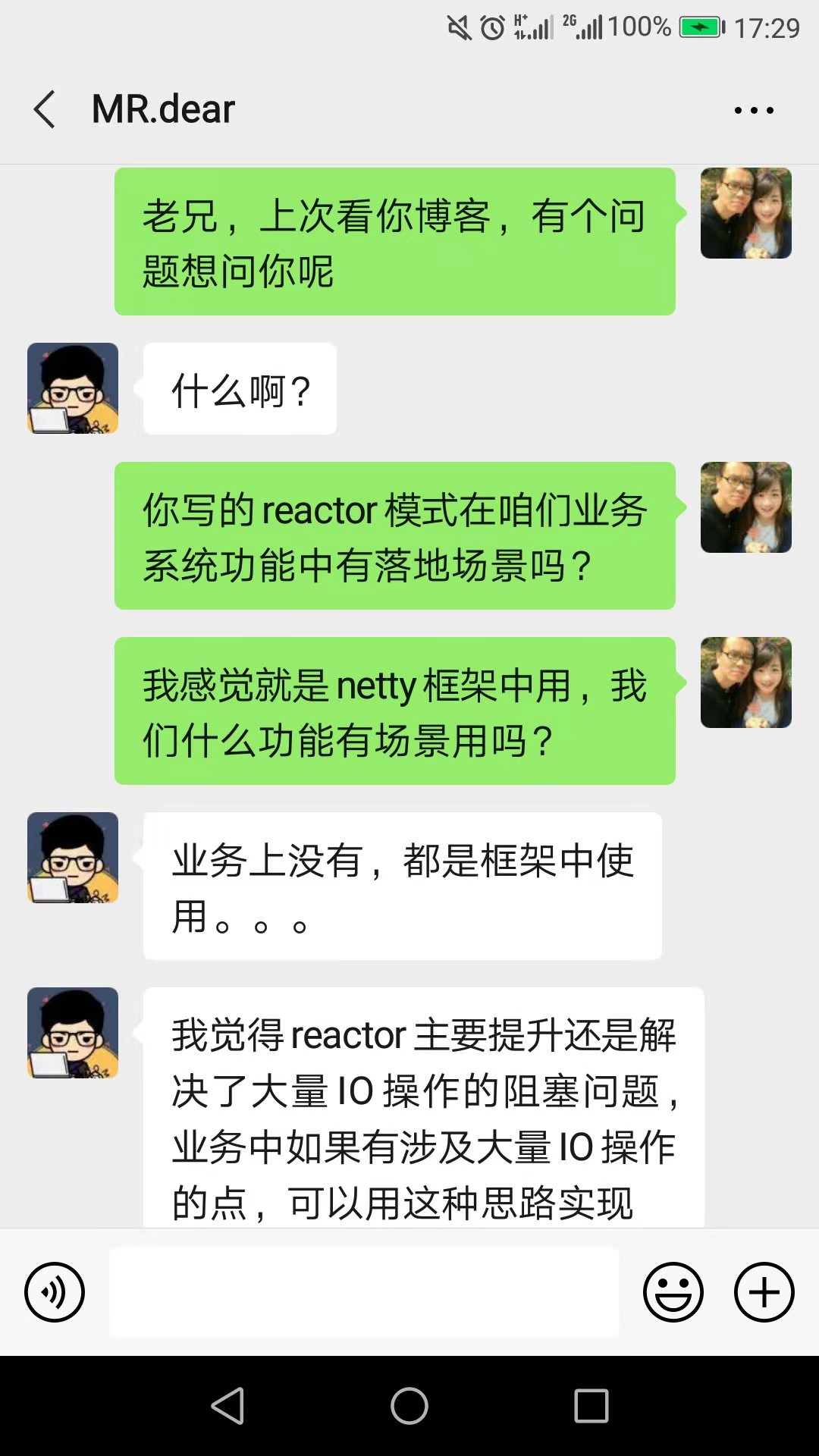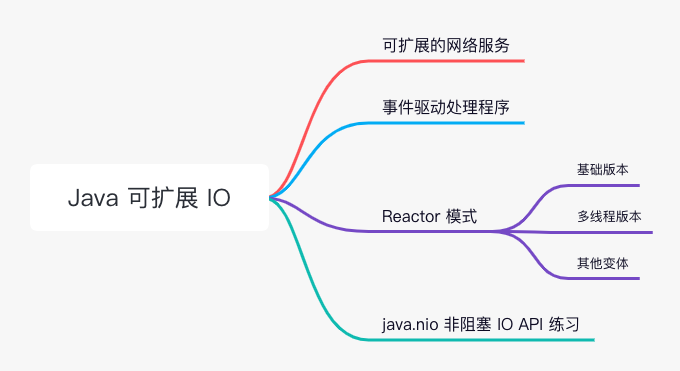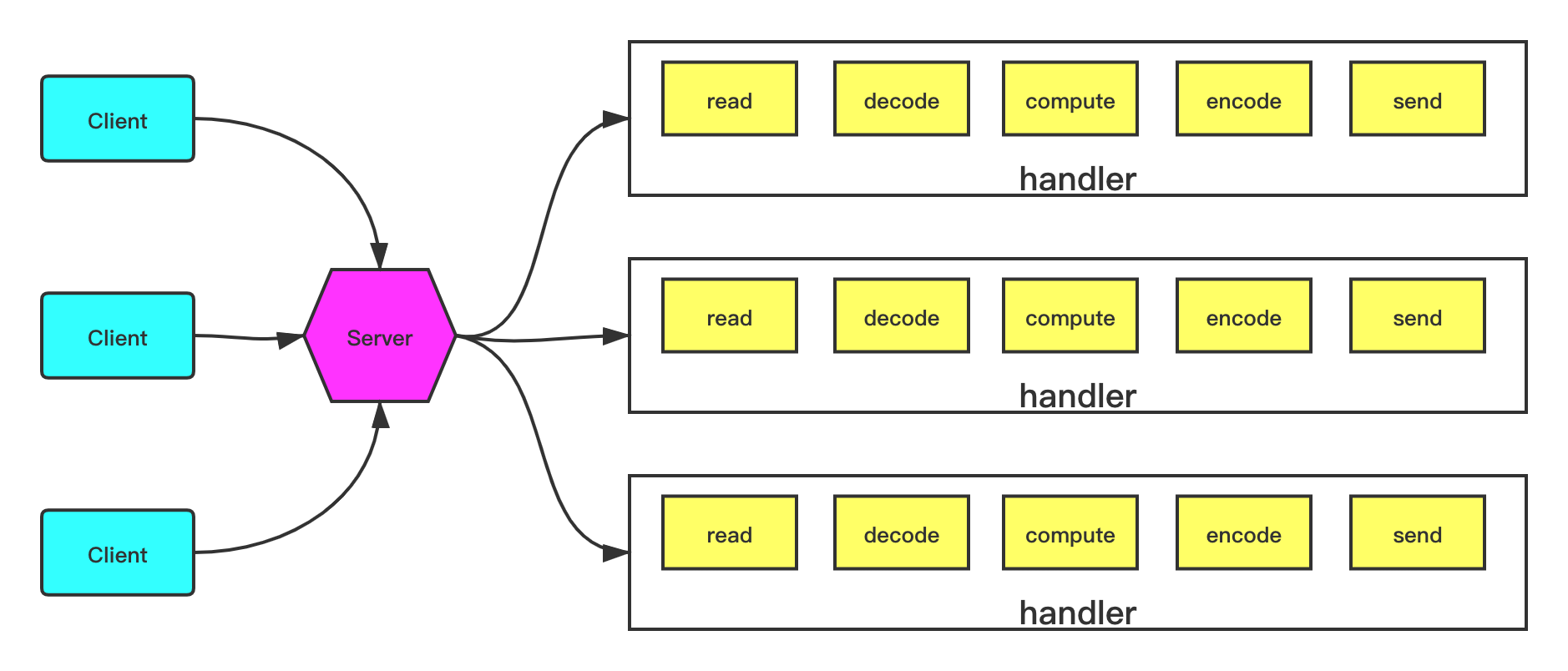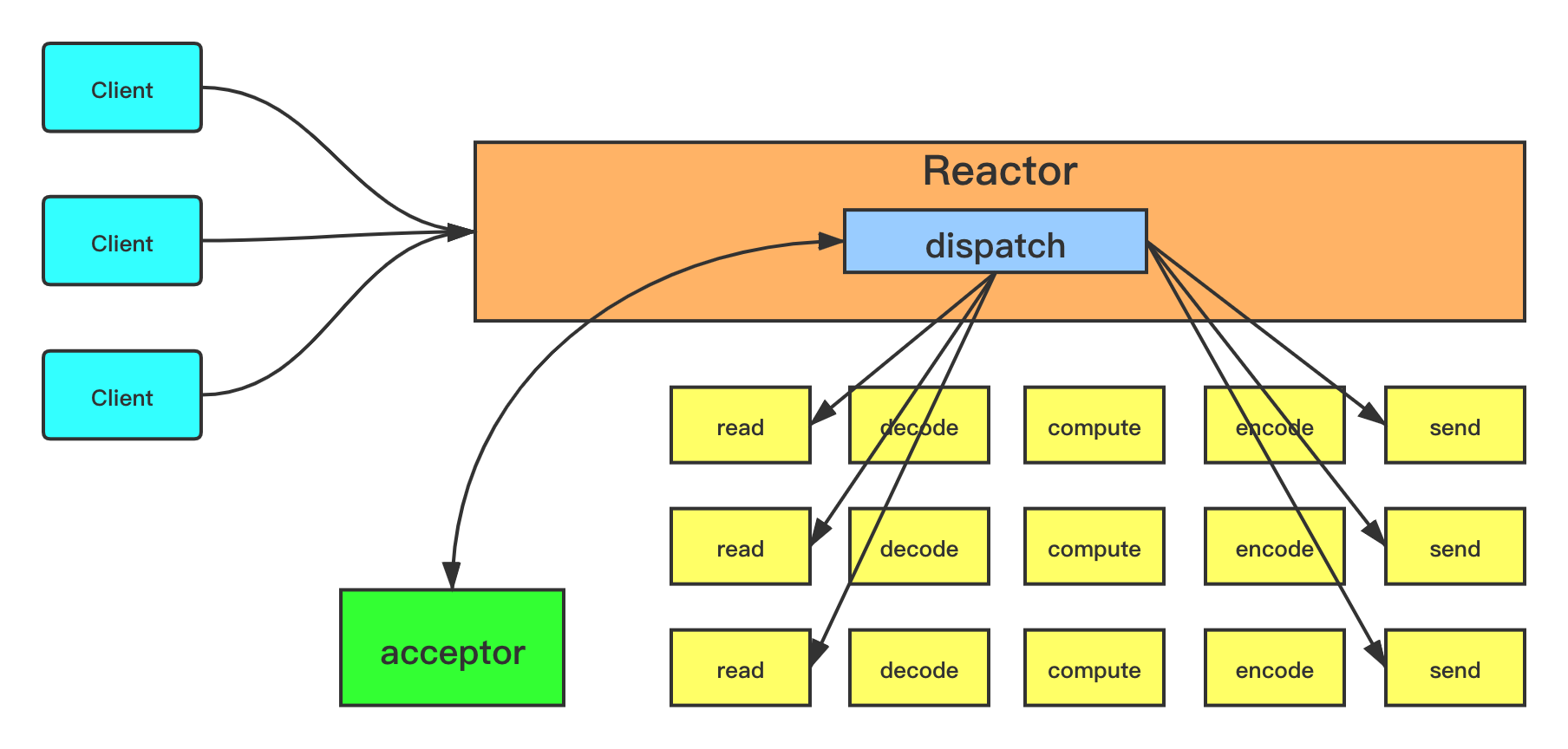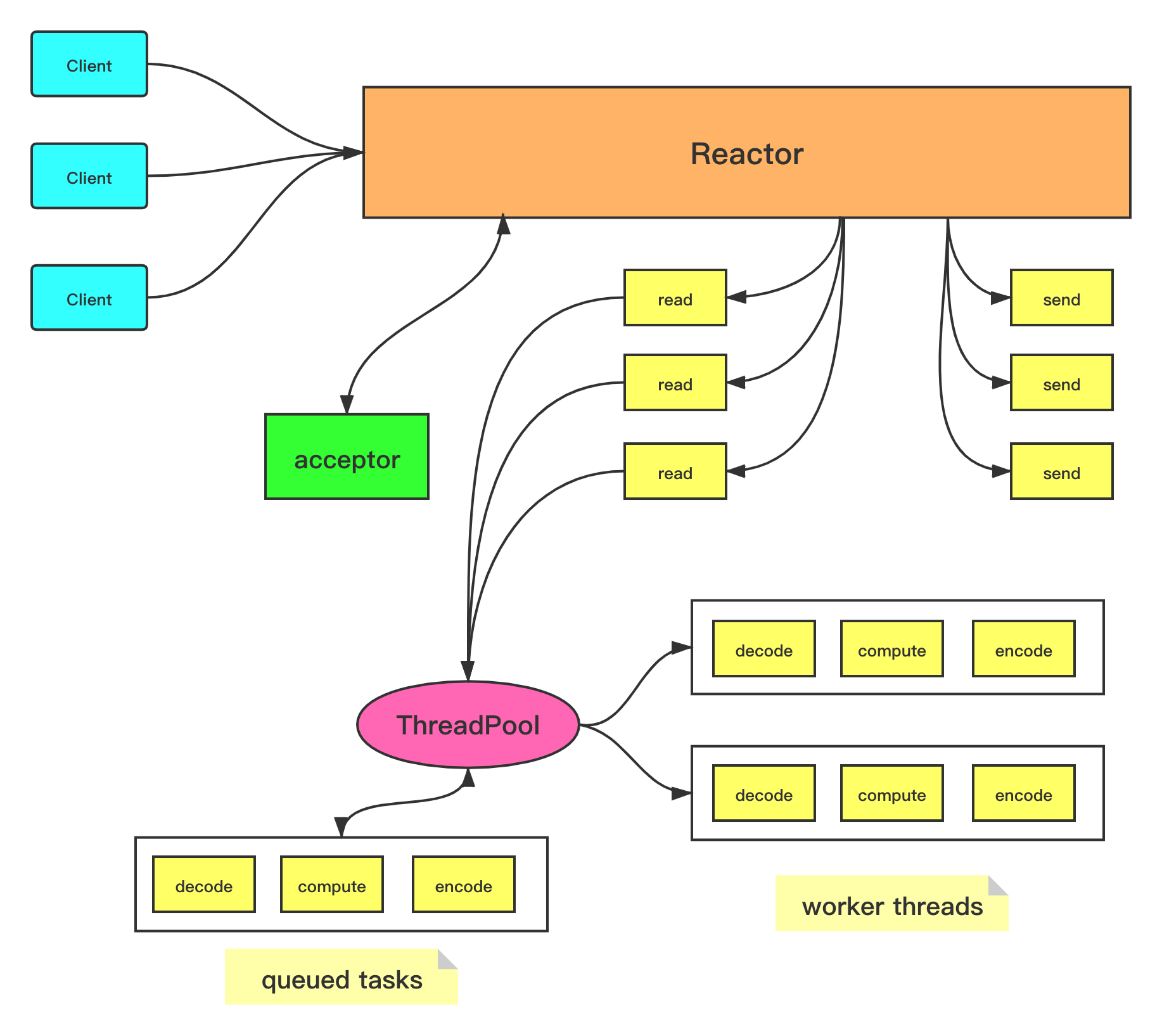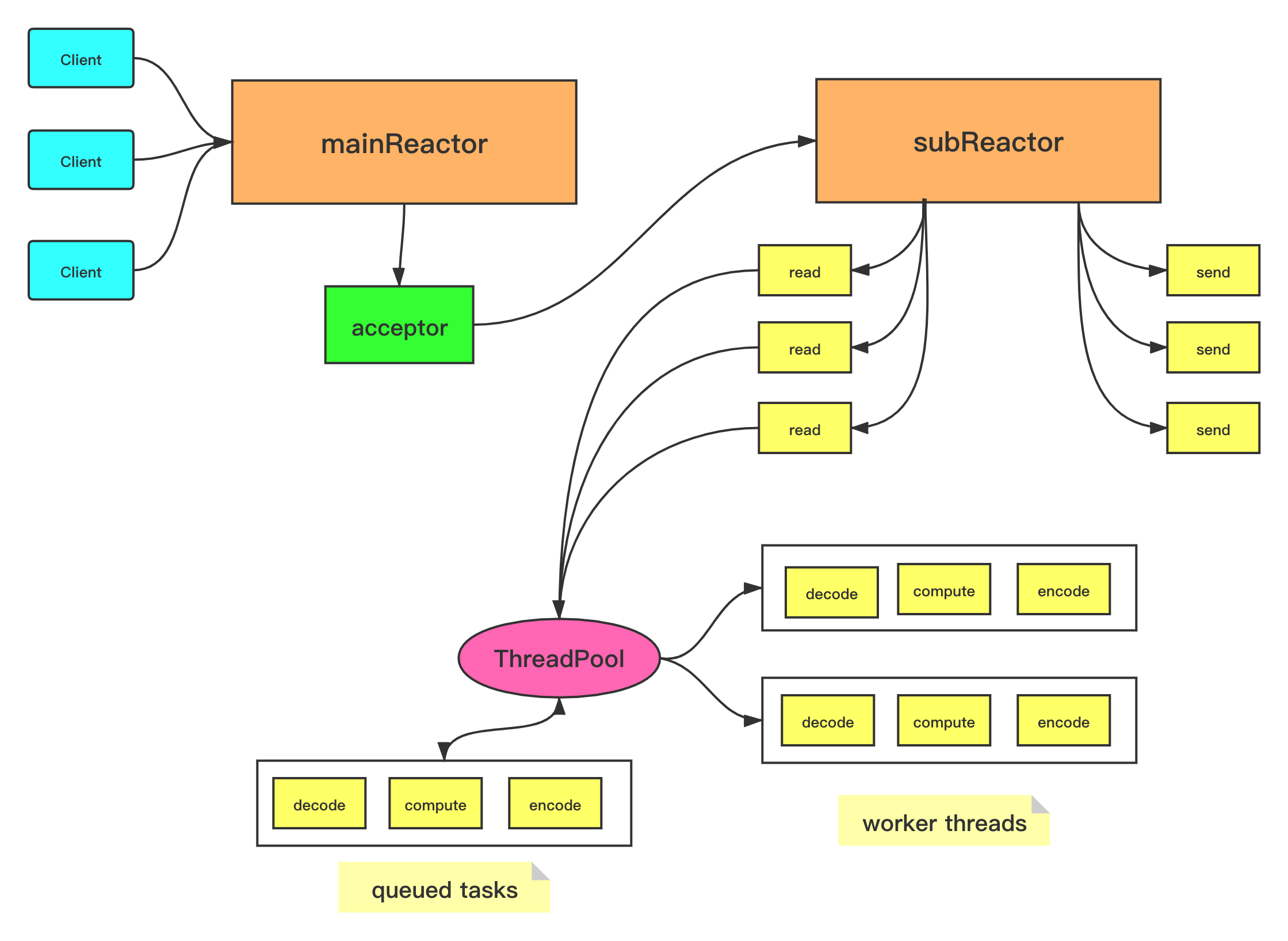背景介绍介绍介绍 周末随便学习一些东西,在屈定 老兄的博客上看到更新了一篇文章《Netty – Reactor模型的应用》 ,内容分析的很到位,对于 Reactor 模式,我了解到的主要还是在 Netty 框架中的线程模式使用的是 Reactor 模式,有时会想这个东西在在我们的业务系统中会有什么样的应用场景,是不是有机会在某些功能中落地到我们的项目中,而不是一直高高在上,为此还和屈定老兄交流了一下。
看来这个东西也只是“此曲只应天上有,人间能得几回闻”,业务系统落地机会看来不多,也可能还需要慢慢探索,不过还是想在学习一下,不要只是肤浅的理解。
如果在谷歌上搜索 Reactor 模式的知识,搜索结果里面一定会有 Doug Lea 大师《Scalable IO in Java》文档内容,看这个文档内容应该是一次知识分享的 PPT 内容,而且很多分析 Reactor 模式的博客文章大部分在引用里面都会提到《Scalable IO in Java》内容,这次的学习也集中在这个文档的内容。
目录 可扩展的网络服务 网络服务 在这一节中,Doug Lea 大师总结了在 web 应用服务、分布式服务中一般包括如下一些基本的处理流程:
Read request(读请求,比如说 web 请求中的 HttpRequest)
Decode request(解析 Request 数据)
Process service (业务逻辑处理)
Encode reply (包装响应数据)
Send reply(发送响应结果,比如说 web 请求中的 HttpReponse)
这个处理流程中不同的是每次需要进行的 XML 解析,文件传输、web 网页生成,服务计算等内容… …
经典服务设计 每一个 handler 处理流程可能会启动一个自己独享的线程。
1 2 3 4 5 6 7 8 9 10 11 12 13 14 15 16 17 18 19 20 21 22 23 24 25 26 27 28 29 30 31 32 33 34 35 36 37 38 39 40 class Server implements Runnable { @Override public void run () { try { ServerSocket ss = new ServerSocket (PORT); while (!Thead.interrupted()) { new Thread (new Handler (ss.accept())).start(); } } catch (IOException ex) { } } static class Handler implements Runnable { final Socket socket; Handler(Socket s) { socket = s; } @Override public void run () { try { byte [] input = new byte [MAX_INPUT]; socket.getInputStream().read(input); byte [] output = process(input); socket.getOutputStream().write(output); } catch (IOException ex) { } } private byte [] process(byte [] cmd) { } } }
可扩展性目标 分而治之的思想 将整个处理流程分割成为一些小的任务,每个任务执行一个动作而不会产生阻塞。
当某个时刻任务被启用时,开始执行这个任务;在整个过程中,IO 事件作为任务启用的触发器。
java.nio 实现的基本机制:
非阻塞的读操作和写操作
监测 IO 相关事件的调度任务程序
无限变化的可能
事件驱动设计 事件驱动的设计通常比替代方案更加有效:
事件驱动的设计通常比替代方案程序实现更加复杂:
必须分解成简单的非阻塞动作
类似于 GUI 事件驱动的操作
无法消除所有阻塞:GC,页面错误等
必须跟踪逻辑服务状态
背景介绍:AWT 中的事件 事件驱动的 IO 使用相似的想法,但设计不同
Reactor 模式 Reactor 通过调度适当的处理程序来响应 IO 事件(和 AWT 中的线程作用非常类似)
Handler 用于完成非阻塞的动作(和 AWT 中 ActionListeners 作用类似)
通过将处理程序绑定到事件进行管理(和 AWT 中 addActionListener 作用类似)
参见:Schmidt et al, Pattern-Oriented Software Architecture, Volume 2 (POSA2)
Reactor 模式基本实现 单线程版本实现
java.nio 支持 Channels:Channel 用于实现非阻塞读操作,可以连接到文件、Socket 等;
Buffers:Buffer 类似于对象数组,能够直接通过 Channel 进行读写操作;
Selectors:判断一组 Channel 中的哪些发生了 IO 事件;
SelectionKeys:维护 IO 事件状态和绑定状态
Reactor 模式第一步:启动 1 2 3 4 5 6 7 8 9 10 11 12 13 14 15 16 17 18 19 20 21 22 class Reactor implements Runnable { final Selector selector; final ServerSocketChannel serverSocket; public Reactor (int port) throws IOException { selector = Selector.open(); serverSocket = ServerSocketChannel.open(); serverSocket.socket().bind(new InetSocketAddress (port)); serverSocket.configureBlocking(false ); SelectionKey sk = serverSocket.register(selector, SelectionKey.OP_ACCEPT); sk.attach(new Acceptor ()); } }
Reactor 模式第二步:循环调度 1 2 3 4 5 6 7 8 9 10 11 12 13 14 15 16 17 18 19 20 21 22 23 @Override public void run () { try { while (!Thread.interrupted()) { selector.select(); Set selected = selector.selectedKeys(); Iterator it = selected.iterator(); while (it.hasNext()) { dispatch((SelectionKey)(it.next())); selected.clear(); } } } catch (IOException ex) { } } void dispatch (SelectionKey k) { Runnable r = (Runnable) (k.attachment()); if (r != null ) { r.run(); } }
Reactor 模式第三步:Acceptor 1 2 3 4 5 6 7 8 9 10 11 12 13 14 class Acceptor implements Runnable { @Override public void run () { try { SocketChannel c = serverSocket.accept(); if (c != null ) { new Handler (selector, c); } } catch (IOException ex) { } } }
Reactor 模式第四步:Handler 启动 1 2 3 4 5 6 7 8 9 10 11 12 13 14 15 16 17 18 19 20 21 final class Handler implements Runnable { final SocketChannel socket; final SelectionKey sk; ByteBuffer input = ByteBuffer.allocate(MAXIN); ByteBuffer ouput = ByteBuffer.allocate(MAXOUT); static final int READING = 0 , SENDING = 1 ; int state = READING; public Handler (Selector sel, SocketChannel c) throws IOException { socket = c; c.configureBlocking(false ); sk = socket.register(sel, 0 ); sk.attach(this ); sk.interestOps(SelectionKey.OP_READ); sel.wakeup(); } boolean inputIsComplete () { } boolean outputIsComplete () { } void process () { }
Reactor 模式第五步:请求处理 1 2 3 4 5 6 7 8 9 10 11 12 13 14 15 16 17 18 19 20 21 22 23 24 25 26 27 28 29 @Override public void run () { try { if (state = READING) { read(); } else if (state = SENDING) { send(); } } catch (IOException ex) { } } void read () throws IOException { socket.read(input); if (inputIsComplete()) { process(); state = SENDING; sk.interestOps(SelectionKey.OP_WRITE); } } void send () throws IOException { socket.write(ouput); if (inputIsComplete()) { sk.cancel(); } }
单个状态处理程序 GoF 中状态模式的简单应用:重新绑定适当的处理程序作为附件
1 2 3 4 5 6 7 8 9 10 11 12 13 14 15 16 17 18 19 20 21 22 class Handler { public void run () { socket.read(input); if (inputIsComplete()) { process(); sk.attach(new Sender ()); sk.interest(SelectionKey.OP_WRITE); sk.selector().wakeup(); } } class Sender implements Runnable { @Override public void run () { socket.write(output); if (outputIsComplete()) sk.cancel(); } } }
多线程设计实现 工作线程 卸载非 IO 处理以加速 Reactor 线程:与 POSA2 Proactor 设计类似 PS. 工作线程用于处理 IO 事件,Reactor 线程不用关心 IO 事件,这样可以提升 Reactor 线程 处理速度
比将计算绑定处理重新加工成事件驱动的形式更简单:应该仍然是纯非阻塞计算,足够的处理胜过开销
但是很难将处理与 IO 重叠:最好某个时刻可以先将所有输入读入缓冲区
使用线程池,因此可以进行调整和控制:通常需要比客户端少的线程
工作线程池 线程池处理器 1 2 3 4 5 6 7 8 9 10 11 12 13 14 15 16 17 18 19 20 21 22 23 24 25 26 27 class Handler { static PooledExecutor pool = new PooledExecutor (...); static final int PROCESSING = 3 ; synchronized void read () { socket.read(input); if (inputIsComplete()) { state = PROCESSING; pool.execute(new Processer ()); } } synchronized void processAndHandOff () { process(); state = SENDING; sk.interest(SelectionKey.OP_WRITE); } class Processer implements Runnable { public void run () { processAndHandOff(); } } }
协调任务 Handoffs
每个任务都会启用,触发或调用下一个任务
通常最快,但可能很脆弱
Callbacks:回调每个处理程序的调度程序
设置状态,附件等
GoF Mediator 模式的变体
Queues
Futures
当每个任务产生结果时
协作位于联接或等待 / 通知之上
使用线程池执行器 多个 Reactor 线程模式 使用 Reactor 对象池
主 acceptor 负责分配到其他的 Reactor
1 2 3 4 5 6 7 8 9 10 11 12 13 Selector[] selectors; int next = 0 ;class Acceptor { public synchronized void run () { ... Socket connection = serverSocket.accept(); if (connection != null ) { new Handler (selectors[next], connection); } if (++next == selectors.length) { next = 0 ; } } }
使用多 Reactor 模式 使用其他的 java.nio 特性 每个 Reactor 支持多个 Selector
将不同的处理程序绑定到不同的 IO 事件
需要仔细处理同步操作来进行协调
文件传输
内存映射文件
直接缓冲
有时可以实现零拷贝传输
但是启动和完成会产生额外的开销
最适合连接时间较长的应用
基于连接的扩展 非单个服务请求处理
客户端连接
客户端发送一系列的消息 / 请求
断开客户端连接
示例场景
可扩展的基础网络服务模式
处理许多存活时间相对较长的客户端请求
跟踪客户端和会话状态(包括丢弃)
跨多个主机分配服务
API 练习 Buffer 1 2 3 4 5 6 7 8 9 10 11 12 13 14 15 16 abstract class Buffer { int capacity () ; int position () ; Buffer position (int newPosition) ; int limit () ; Buffer limit (int newLimit) ; Buffer mark () ; Buffer reset () ; Buffer clear () ; Buffer flip () ; Buffer rewind () ; int remaining () ; boolean hasRemaining () ; boolean isReadOnly () ; }
ByteBuffer 1 2 3 4 5 6 7 8 9 10 11 12 13 14 15 16 17 18 19 20 21 22 23 24 25 26 27 28 29 30 31 32 33 34 35 36 37 38 39 40 41 42 43 44 45 46 47 48 49 50 51 52 53 abstract class ByteBuffer extends Buffer { static ByteBuffer allocateDirect (int capacity) ; static ByteBuffer allocate (int capacity) ; static ByteBuffer wrap (byte [] src, int offset, int len) ; static ByteBuffer wrap (byte [] src) ; boolean isDirect () ; ByteOrder order () ; ByteBuffer order (ByteOrder bo) ; ByteBuffer slice () ; ByteBuffer duplicate () ; ByteBuffer compact () ; ByteBuffer asReadOnlyBuffer () ; byte get () ; byte get (int index) ; ByteBuffer get (byte [] dst, int offset, int length) ; ByteBuffer get (byte [] dst) ; ByteBuffer put (byte b) ; ByteBuffer put (int index, byte b) ; ByteBuffer put (byte [] src, int offset, int length) ; ByteBuffer put (ByteBuffer src) ; ByteBuffer put (byte [] src) ; char getChar () ; char getChar (int index) ; ByteBuffer putChar (char value) ; ByteBuffer putChar (int index, char value) ; CharBuffer asCharBuffer () ; short getShort () ; short getShort (int index) ; ByteBuffer putShort (short value) ; ByteBuffer putShort (int index, short value) ; ShortBuffer asShortBuffer () ; int getInt () ; int getInt (int index) ; ByteBuffer putInt (int value) ; ByteBuffer putInt (int index, int value) ; IntBuffer asIntBuffer () ; long getLong () ; long getLong (int index) ; ByteBuffer putLong (long value) ; ByteBuffer putLong (int index, long value) ; LongBuffer asLongBuffer () ; float getFloat () ; float getFloat (int index) ; ByteBuffer putFloat (float value) ; ByteBuffer putFloat (int index, float value) ; FloatBuffer asFloatBuffer () ; double getDouble () ; double getDouble (int index) ; ByteBuffer putDouble (double value) ; ByteBuffer putDouble (int index, double value) ; DoubleBuffer asDoubleBuffer () ; }
Channel 1 2 3 4 5 6 7 8 9 10 11 12 13 14 15 16 17 18 19 20 21 22 interface Channel { boolean isOpen () ; void close () throws IOException; } interface ReadableByteChannel extends Channel { int read (ByteBuffer dst) throws IOException; } interface WritableByteChannel extends Channel { int write (ByteBuffer src) throws IOException; } interface ScatteringByteChannel extends ReadableByteChannel { int read (ByteBuffer[] dsts, int offset, int length) throws IOException; int read (ByteBuffer[] dsts) throws IOException; } interface GatheringByteChannel extends WritableByteChannel { int write (ByteBuffer[] srcs, int offset, int length) throws IOException; int write (ByteBuffer[] srcs) throws IOException; }
SelectableChannel 1 2 3 4 5 6 7 8 9 abstract class SelectableChannel implements Channel { int validOps () ; boolean isRegistered () ; SelectionKey keyFor (Selector sel) ; SelectionKey register (Selector sel, int ops) throws ClosedChannelException; void configureBlocking (boolean block) throws IOException; boolean isBlocking () ; Object blockingLock () ; }
SocketChannel 1 2 3 4 5 6 7 8 9 10 11 12 13 14 15 16 17 18 abstract class SocketChannel implements ByteChannel ... { static SocketChannel open () throws IOException; Socket socket () ; int validOps () ; boolean isConnected () ; boolean isConnectionPending () ; boolean isInputOpen () ; boolean isOutputOpen () ; boolean connect (SocketAddress remote) throws IOException; boolean finishConnect () throws IOException; void shutdownInput () throws IOException; void shutdownOutput () throws IOException; int read (ByteBuffer dst) throws IOException; int read (ByteBuffer[] dsts, int offset, int length) throws IOException; int read (ByteBuffer[] dsts) throws IOException; int write (ByteBuffer src) throws IOException; int write (ByteBuffer[] srcs, int offset, int length) throws IOException;int write (ByteBuffer[] srcs) throws IOException; }
ServerSocketChannel 1 2 3 4 5 6 abstract class ServerSocketChannel extends ... { static ServerSocketChannel open () throws IOException; int validOps () ; ServerSocket socket () ; SocketChannel accept () throws IOException; }
FileChannel 1 2 3 4 5 6 7 8 9 10 11 12 13 14 15 16 17 18 19 20 21 22 23 24 abstract class FileChannel implements ... { int read (ByteBuffer dst) ; int read (ByteBuffer dst, long position) ; int read (ByteBuffer[] dsts, int offset, int length) ; int read (ByteBuffer[] dsts) ; int write (ByteBuffer src) ; int write (ByteBuffer src, long position) ; int write (ByteBuffer[] srcs, int offset, int length) ; int write (ByteBuffer[] srcs) ; long position () ; void position (long newPosition) ; long size () ; void truncate (long size) ; void force (boolean flushMetaDataToo) ; int transferTo (long position, int count, WritableByteChannel dst) ; int transferFrom (ReadableByteChannel src, long position, int count) ; FileLock lock (long position, long size, boolean shared) ; FileLock lock () ; FileLock tryLock (long pos, long size, boolean shared) ; FileLock tryLock () ; static final int MAP_RO, MAP_RW, MAP_COW; MappedByteBuffer map (int mode, long position, int size) ; } NOTE: ALL methods throw IOException
Selector 1 2 3 4 5 6 7 8 9 10 abstract class Selector { static Selector open () throws IOException; Set keys () ; Set selectedKeys () ; int selectNow () throws IOException; int select (long timeout) throws IOException; int select () throws IOException; void wakeup () ; void close () throws IOException; }
SelectionKey 1 2 3 4 5 6 7 8 9 10 11 12 13 14 15 16 abstract class SelectionKey { static final int OP_READ, OP_WRITE, OP_CONNECT, OP_ACCEPT; SelectableChannel channel () ; Selector selector () ; boolean isValid () ; void cancel () ; int interestOps () ; void interestOps (int ops) ; int readyOps () ; boolean isReadable () ; boolean isWritable () ; boolean isConnectable () ; boolean isAcceptable () ; Object attach (Object ob) ; Object attachment () ; }
参考链接 
